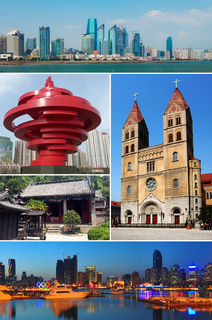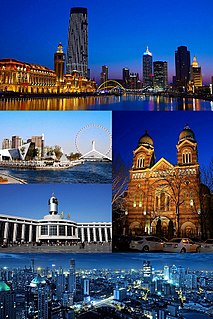China used to operated several separate maritime law enforcement agencies. These services operated ships as well as their own small aviation units to assist their maritime patrol capabilities. These agencies were often referred to as the "Five Dragons".In March 2013, China announced it would form a unified Coast Guard commanded by the State Oceanic Administration. The new Coast Guard has been in operation since July 2013.

Lanzhou is the lead ship of the Chinese Type 052C destroyer class. The ship was laid down in late 2002, launched on 29 April 2003, and commissioned in July 2004. The destroyer is active with the People's Republic of China's South Sea Fleet.
The Port of Tianjin falls under the supervisory and regulatory purview of the Tianjin Municipality People’s Government. The 2004 incorporation of the Tianjin Port Authority into TPG formally divested the group of its role as Port Regulator, which passed to the Tianjin Transportation and Port Authority (天津市交通运输和港口管理局), formerly the Tianjin Transport Commission. The TTPA implements state policy on port work; drafts local policies, by-laws and regulations; and licenses, audits, and issues certifications to businesses operating in the port, in particular to ship terminals. The TTPA supervises and manages compliance to all laws and regulations regarding environmental protection, service compliance, pilotage, maintenance of port infrastructure and handling of dangerous goods and disinfection in all terminals and storage areas.
Haijian 50 is a patrol ship under the flag of the East China Sea Fleet from the East China Sea Branch under the command of the State Oceanic Administration of China, which was commissioned in June 2011. It is the sister ship to Haijian 83, and also the parent ship for the subsequent build of five other ships within the same 3000 tonnage class.
Haijian 46 is a China Marine Surveillance (CMS) ship in the 4th Marine Surveillance Flotilla of the East China Sea Fleet. On September 11, 2012, after Japanese Prime Minister Yoshihiko Noda nationalised the Diaoyu/Senkaku Islands from its private owners - the Kurihara family for ¥2.05bn, Haijian 46 and Haijian 49 set out to conduct operations in the waters around the disputed islands.
Haijian 49 is a China Marine Surveillance (CMS) ship in the 4th Marine Surveillance Flotilla of the East China Sea Fleet. On September 11, 2012, after Japanese Prime Minister Yoshihiko Noda decided to "purchase" Diaoyu Islands from its "private owner", Haijian 46 and Haijian 49 set out to conduct cruise operations in waters around the disputed Diaoyu Islands.
Haijian 51 is a China Marine Surveillance (CMS) ship in the 5th Marine Surveillance Flotilla of the East China Sea Fleet. She was christened and commissioned on November 11, 2005 at her 5th Marine Surveillance Flotilla's dock in Shanghai. The first captain was He Xuming.
Haijian 26 is a China Marine Surveillance (CMS) ship in the 1st Marine Surveillance Flotilla of the North China Sea Fleet. Haijian 26 has been conducting periodic, regular cruise operations in the disputed waters around the Diaoyu Islands. On May 27, 2013, Haijian 26 cruise group entered the disputed waters around the Diaoyu Islands to expel fishing boats sailed by Japanese right-wing Ganbare Nippon activists.
Haijian 15 is a China Marine Surveillance (CMS) ship in the 1st Marine Surveillance Flotilla of its North China Sea Fleet. She is the first ship of the second building plan that includes seven new CMS ships. Haijian 15 was christened and commissioned on January 6, 2011 at her home port of Qingdao. Haijian 15 has been frequently conducting cruise operations in disputed waters around the Diaoyu Islands. In 2012 alone, Haijian 15 has been deployed to waters around the Diaoyu Islands four times, for 103 days in total. She once sailed to a position that is 1.55 nm away from the main island, Diaoyu Island, and personnel on board raised China's national flag to assert China's claim of sovereignty over the Diaoyu Islands.
Haijian 52 is a China Marine Surveillance ship in the 5th Marine Surveillance Flotilla of the East China Sea Fleet. Originally christened as "Shijian" and commissioned in 1967 as a comprehensive oceanic survey vessel, Haijian 52 joined CMS, East China Sea Fleet in 2000. It was planned to be inactive in 2007 but her service was extended.
Haijian 84 is a China Marine Surveillance (CMS) ship in the 8th Marine Surveillance Flotilla of the South China Sea Fleet. She was commissioned on May 8, 2011 at the Changzhou port of the 8th Marine Surveillance Flotilla's base. Her completion signified the completion of the second ship building plan of CMS as well.
Haijian 110 is a China Marine Surveillance (CMS) ship in the 1st Marine Surveillance Flotilla of the North China Sea Fleet. She was commissioned on November 12, 2012. Haijian 110 was formerly a tug boat Beituo 710 in the North China Sea Fleet of PLA Navy. She was decommissioned from the China's armed forces, retrofitted for maritime law enforcement purposes, and recommissioned to CMS.She was renamed China Coast Guard 1310 in 2013.
Haijian 75 is a China Marine Surveillance (CMS) ship in the 7th Marine Surveillance Flotilla of CMS's South China Sea Fleet. She is one of the fastest CMS ships in the second building plan. She was commissioned on October 26, 2010.
South China Sea Fleet, China Marine Surveillance is under command of both South China Sea Branch, State Oceanic Administration and China Marine Surveillance.
East China Sea Fleet, China Marine Surveillance is under command of both East China Sea Branch, State Oceanic Administration and China Marine Surveillance.
Haijian 23 is a China Marine Surveillance (CMS) ship in the 1st Marine Surveillance Flotilla of its North China Sea Fleet. Haijian 23 was christened and commissioned on January 6, 2011 at her home port of Qingdao. Haijian 23 has been frequently conducting cruise operations in territorial waters around Diaoyu Islands.

The Tsunami Advisory Center of the Ministry of National Resources is a Chinese administrative agency to prevent tsunamis damage in the coastal areas in China. This agency, founded in 2013, is subordinate to the Ministry of Natural Resources of the People's Republic of China, National Marine Environment Forecasting Center and provides timely information service of Tsunami warning system to the coastal areas in China and the surrounding countries in South China Sea. It is a public institution of financial subsidies and its headquarter is in No 8, Dahui Temple Road, Haiding District, Beijing. The agency has another listing name--South China Sea Tsunami Advisory Center (SCSTAC) of UNESCO/IOC, with an abbreviated form of South China Sea Tsunami Advisory Center (SCSTAC), offering supervising and warning service of tsunami for countries such as China, Brunei, Cambodia, Indonesia, Malaysia, Philippines, Singapore, Thailand, Vietnam. The current director is Yuan Ye and the chief forecaster is Zhao Lianda








